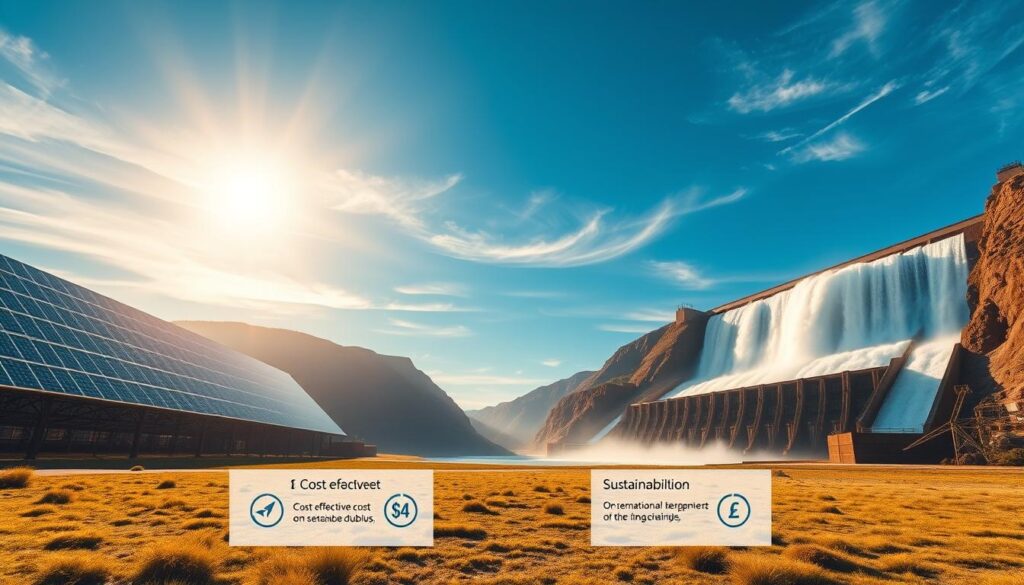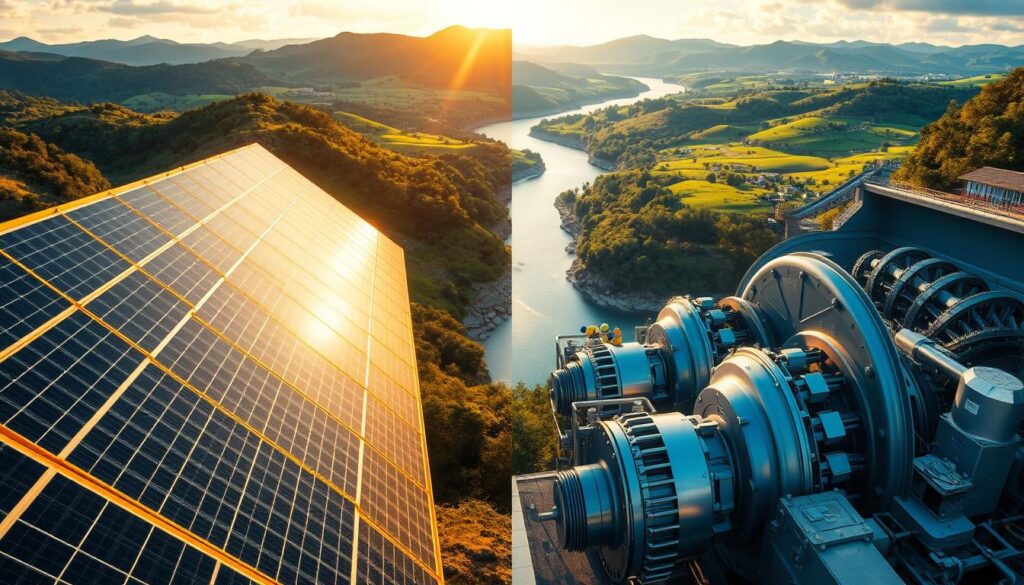
Thinking about renewable energy? You’re probably looking at the costs of solar vs hydropower. It’s important to know the expenses for each. The costs include the initial investment, installation, and upkeep.
In the U.S., the cost of renewable energy matters a lot. When you compare solar vs hydropower, think about the money side. A good comparison will help you choose the best clean energy for you.
Table of Contents
Introduction to solar vs hydropower cost
Looking at solar vs hydropower costs? You need to know what affects these costs. This knowledge helps you pick the right energy for your needs and budget. Comparing costs is key to finding the most affordable clean energy.
Key Takeaways: solar vs hydropower cost
Understanding the solar vs hydropower cost is crucial for making an informed decision about renewable energy investments.
The renewable energy comparison involves evaluating various factors, including initial investment, installation requirements, and maintenance expenses.
Clean energy expenses, such as maintenance and operational costs, play a significant role in determining the overall cost of solar and hydropower energy.
A thorough solar vs hydropower cost comparison will help you determine which option is more affordable and suitable for your energy needs.
The cost of renewable energy is a significant factor in determining its viability in the United States.
Evaluating the economic aspects of solar and hydropower energy will help you make a decision that aligns with your budget and energy requirements.

Understanding Renewable Energy Economics
Exploring renewable energy means diving into its economics. When comparing solar power vs hydroelectricity expenditure, look at the total energy production cost. This includes the initial investment, upkeep, and equipment costs. A detailed energy cost analysis is key to smart energy investment choices.
Renewable energy economics also involves a sustainable energy cost analysis. This analysis compares the costs and benefits of solar and hydroelectric power. It helps figure out which is more affordable and eco-friendly. Costs like equipment, maintenance, and location affect the total energy production cost.
- Equipment costs: The initial investment in solar panels or hydroelectric turbines
- Maintenance costs: The cost of upkeep and repair for the equipment
- Location: The impact of location on energy production, such as sunlight or water flow
Understanding these factors and doing a thoroughenergy cost analysis helps make smart energy investment choices. This way, you can pick the most cost-effective option.
Initial Investment Comparison: Solar vs Hydropower Cost
When looking at the costs of solar and hydropower, it’s key to compare the upfront costs. The prices for equipment, installation, and infrastructure differ a lot. You should look at the hydroelectric vs solar pricing to see which fits your budget better.
The cost of starting up with hydropower might be more, but it could save money in the long run. Solar energy, on the other hand, needs a big upfront investment in panels and setup. But, it has lower costs for upkeep and use.
When comparing hydroelectric vs solar pricing, consider these costs:
- Equipment costs: The price of solar panels, turbines, and other needed gear.
- Installation costs: The price to put in the equipment, including labor and materials.
- Infrastructure costs: The cost to build and keep up the needed setup, like dams or lines.
Knowing these costs and thinking about long-term gains can help you choose. The aim is to find a power source that’s affordable and meets your energy needs without breaking the bank.
Installation and Infrastructure Requirements
When exploring renewable energy, it’s crucial to understand the setup and infrastructure needs for solar and hydropower. You’ll need to compare the costs of green energy. For solar, you’ll need panels, mounts, and enough space for best results.
The cost of clean energy also depends on the needed infrastructure. This includes lines, substations, and more to get the energy to homes and businesses. Knowing these needs helps figure out if solar or hydropower works for you.
- Land use and location factors, such as proximity to energy demand and availability of natural resources
- Equipment and material requirements, including durability and maintenance needs
- Energy storage and grid connection options, to ensure a stable and reliable energy supply
By looking at these details, you can choose wisely for your renewable energy investment. This ensures a smooth switch to clean energy.
Maintenance and Operational Expenses
When looking at solar vs hydropower costs, remember to consider maintenance and operational expenses. Both solar and hydropower have their own needs. Solar panels need regular cleaning for best performance. Hydropower systems require checks on turbines and generators.
It’s important to compare the ongoing costs of each system. This includes replacing equipment, repairs, and monitoring. Knowing these costs helps you choose the more cost-effective option. Key things to consider are:
- Equipment lifespan and replacement costs
- Regular maintenance and inspection schedules
- Monitoring and control system expenses
When comparing solar and hydropower costs, remember their pros and cons. Solar might be cheaper upfront, but hydropower is often more reliable. Your choice depends on your needs and situation. By looking at maintenance and operational costs, you can pick the best clean energy option for you.
Long-term Return on Investment Analysis
Looking at the long-term return on investment for solar and hydropower energy is key. We need to check how much energy each one makes over time. Then, we compare the costs to see which one is the best deal.
Hydropower and solar energy have different costs. Hydropower plants cost a lot upfront but run cheaply. Solar systems are cheaper to start but cost more to keep up over time. It’s important to look at these costs when deciding between hydroelectric vs solar pricing.
Some important things to think about include:
- Energy generation efficiency
- Lifespan of the system
- Financial incentives and tax benefits
- Operating and maintenance costs
By looking at these points and doing a detailed energy cost analysis, you can choose wisely. Think about the long-term benefits and costs of each option. This way, you’ll make a smart investment.
| Energy Source | Upfront Costs | Operating Costs | Lifespan |
|---|---|---|---|
| Hydropower | High | Low | 50-100 years |
| Solar Energy | Low | Medium | 25-30 years |
Environmental Impact and Associated Costs
When looking into cost-effective power sources, it’s key to think about the environmental impact and costs. Investing in renewable energy can greatly cut down your carbon footprint and lessen harm to the environment. A comparison of green energy costs shows that solar and hydropower each have their own pros and cons.
Looking at the environmental impact, you’ll need to think about environmental assessment expenses. These are the costs of checking how the energy might affect local ecosystems. This step helps spot risks and find ways to lessen them. Also, regulatory compliance costs are important to consider. These costs can change based on where you are and the type of renewable energy you choose.
To choose wisely, you must balance the costs and benefits of each option. Here are some important points to keep in mind:
- Environmental assessment expenses: These can cost between $10,000 and $50,000 or more, depending on the complexity.
- Regulatory compliance costs: These can vary a lot, but usually range from $5,000 to $20,000 or more, based on location and energy type.
- Green energy cost comparison: A detailed look at the costs and benefits of solar and hydropower can help you decide which is best for you.
Looking closely at the environmental impact and costs of solar and hydropower can help you make a better choice. Think about the long-term benefits and the potential for a good return on investment.
Choosing Between Solar and Hydro: Location-Specific Factors
Location is key when looking at clean energy pricing for solar and hydropower. The best renewable energy value changes based on where you are, the weather, and the land. For example, places with lots of sun and little water might find solar energy cheaper.
Local climate is a big factor. Places with lots of sun are great for solar panels. But, areas with lots of water and the right land are better for hydropower. Also, local rules and policies can affect how much these clean energies cost.
When comparing solar vs hydropower cost, consider these location-specific factors:
- Climate and weather patterns
- Geography and topography
- Local regulations and policies
- Availability of water resources
- Access to existing infrastructure
By looking at these factors, you can pick the best renewable energy for your place. It’s important to think about your location’s unique features. This helps you make a smart choice about clean energy pricing and the best option for you.
Conclusion: Making the Right Investment Choice
When deciding between solar power vs hydroelectricity expenditure, think about your energy needs and where you live. This article has shown the main points to consider for clean energy expenses of solar and hydropower.
Knowing the upfront costs, installation needs, upkeep expenses, and long-term savings is key. This knowledge helps you choose the best renewable energy option for your budget and green goals. Whether you pick solar or hydropower, this article’s insights will guide you to the right choice.

FAQ
What are the key factors that affect the cost of solar and hydropower energy?
Several factors influence the cost of solar and hydropower energy. These include equipment, installation, maintenance, location, and energy production efficiency. Knowing these factors helps when comparing the affordability of these renewable energy options.
How do the initial investment costs of solar and hydropower compare?
The initial costs for solar and hydropower vary. Solar energy usually has lower upfront costs. Hydropower, however, requires a bigger initial investment for infrastructure and equipment. It’s important to look at long-term returns when choosing the most cost-effective option.
What are the ongoing maintenance and operational expenses associated with solar and hydropower energy?
Solar energy systems have lower maintenance and operational costs than hydropower. Solar panels need occasional cleaning and replacement. Hydropower systems require more maintenance, including inspections, repairs, and equipment upgrades. Considering these ongoing costs is key to determining the cost-effectiveness of each option.
How do the environmental impact and associated costs differ between solar and hydropower?
Both solar and hydropower have low environmental impact compared to fossil fuels. However, there are differences in costs. Solar energy requires environmental assessments and compliance with regulations, adding to expenses. Hydropower may have costs for protecting aquatic ecosystems and addressing water source disruptions.
What location-specific factors should be considered when choosing between solar and hydropower energy?
When picking between solar and hydropower, location matters a lot. The climate, geography, and local rules are key. For instance, places with lots of sun are great for solar panels.
On the other hand, areas with steady water flow and the right terrain are best for hydropower. It’s vital to look at these factors to find the best renewable energy option for your area.
